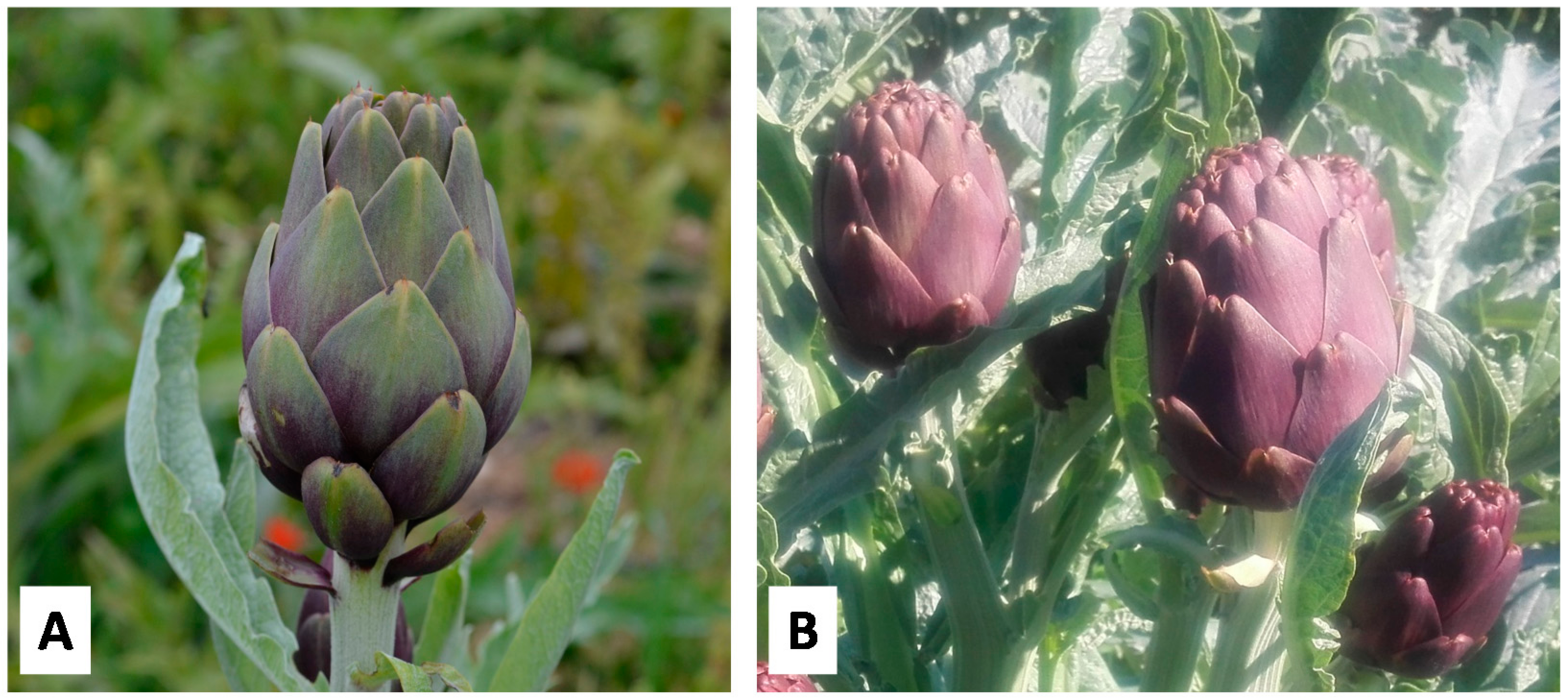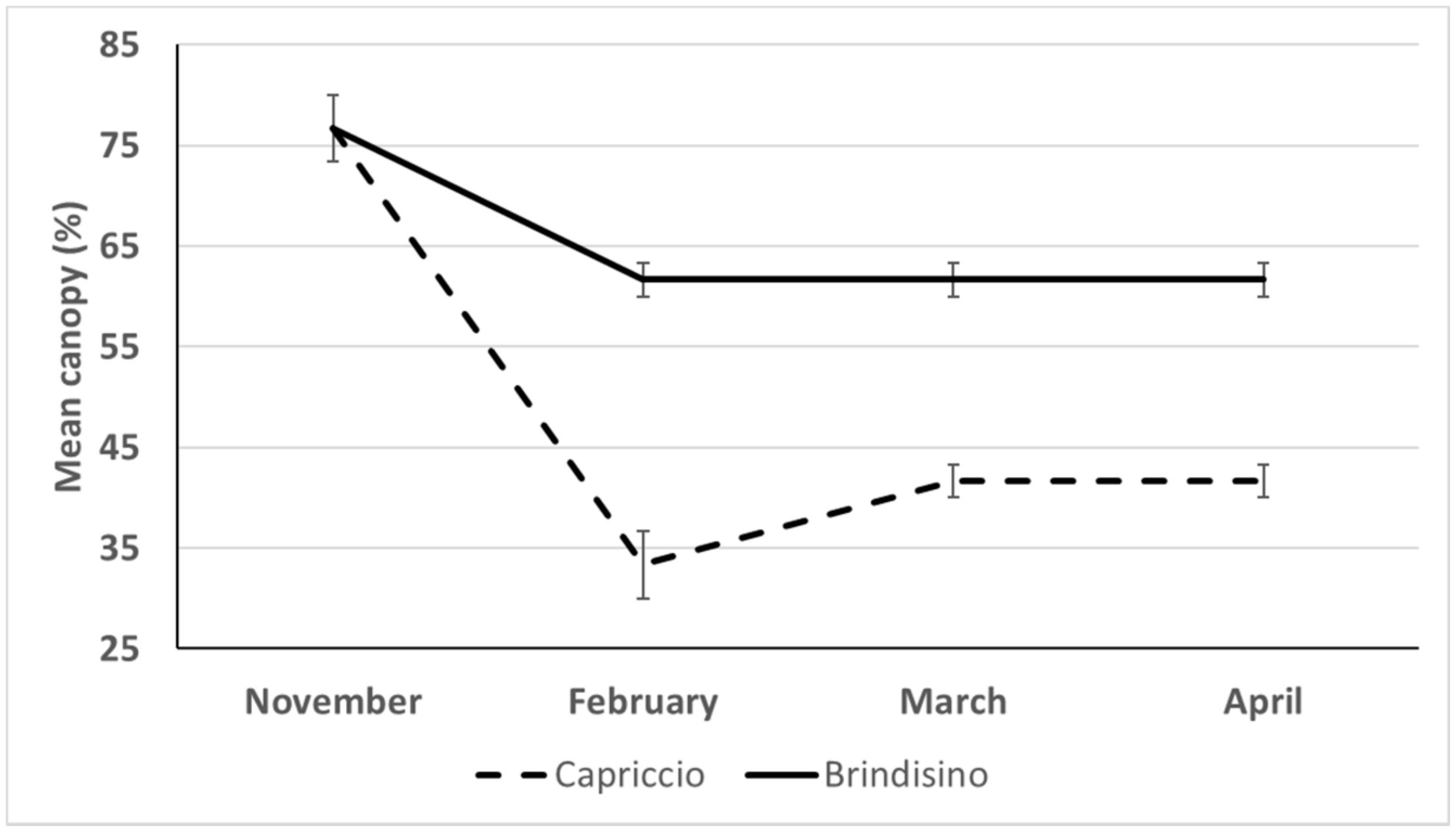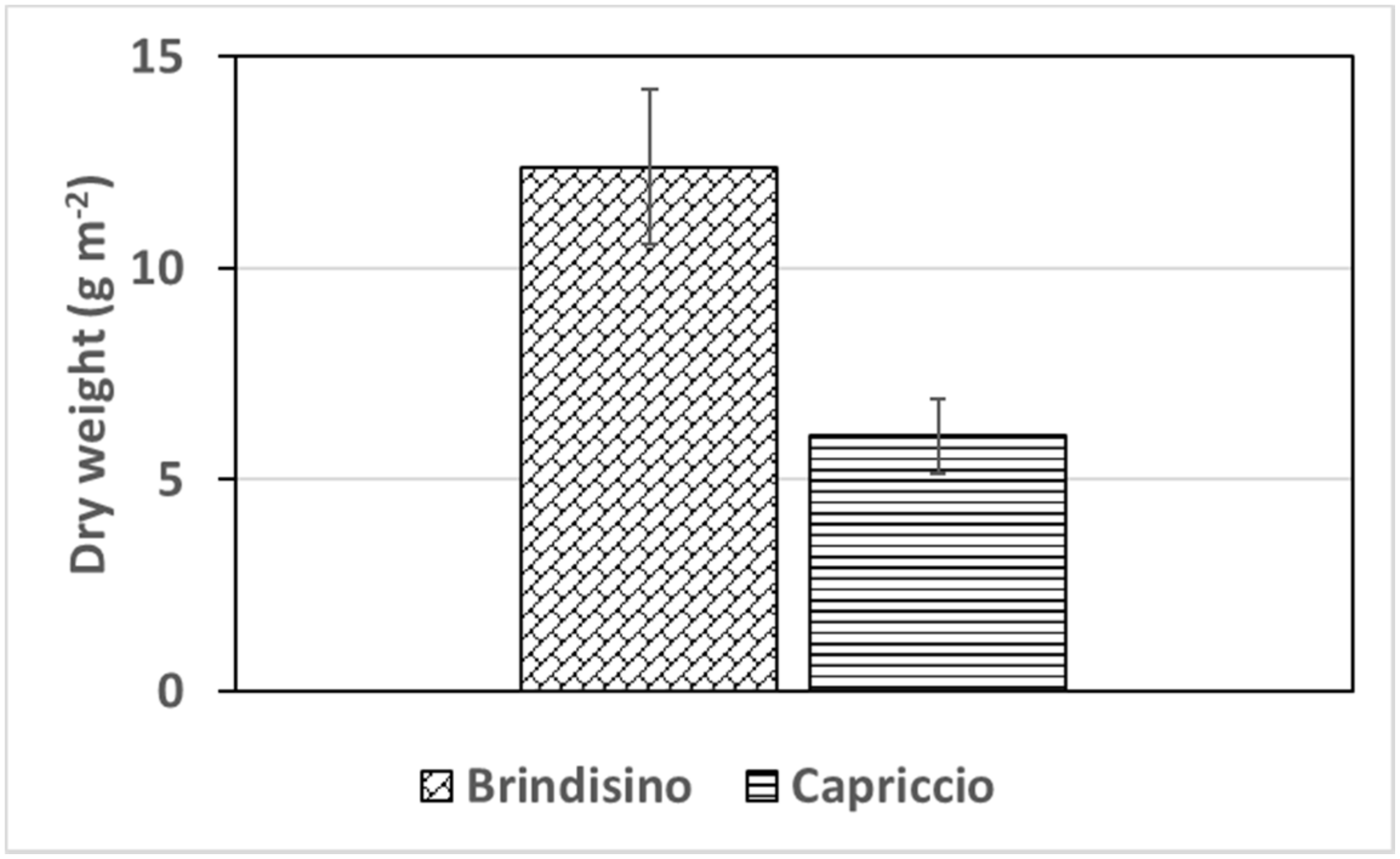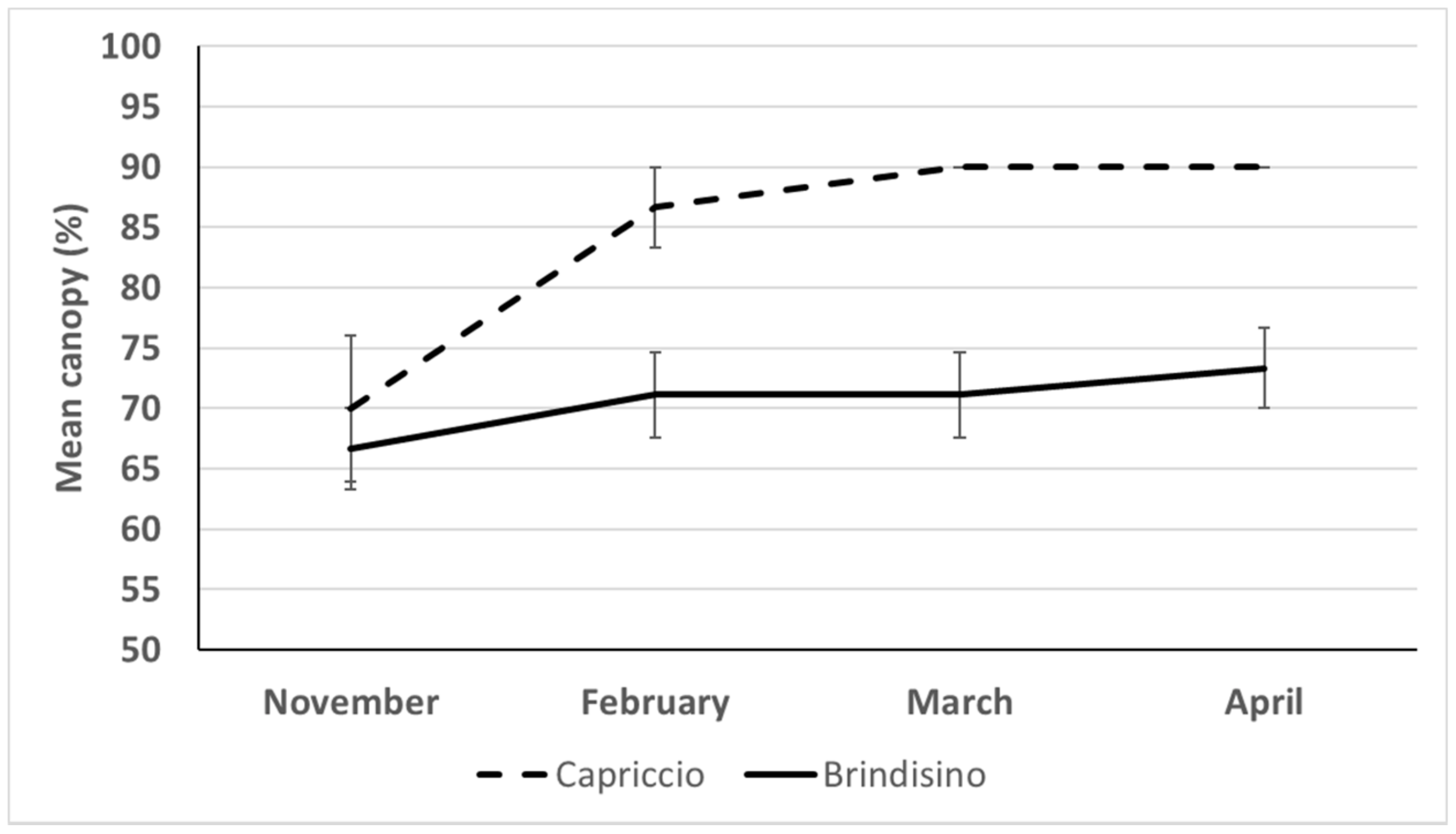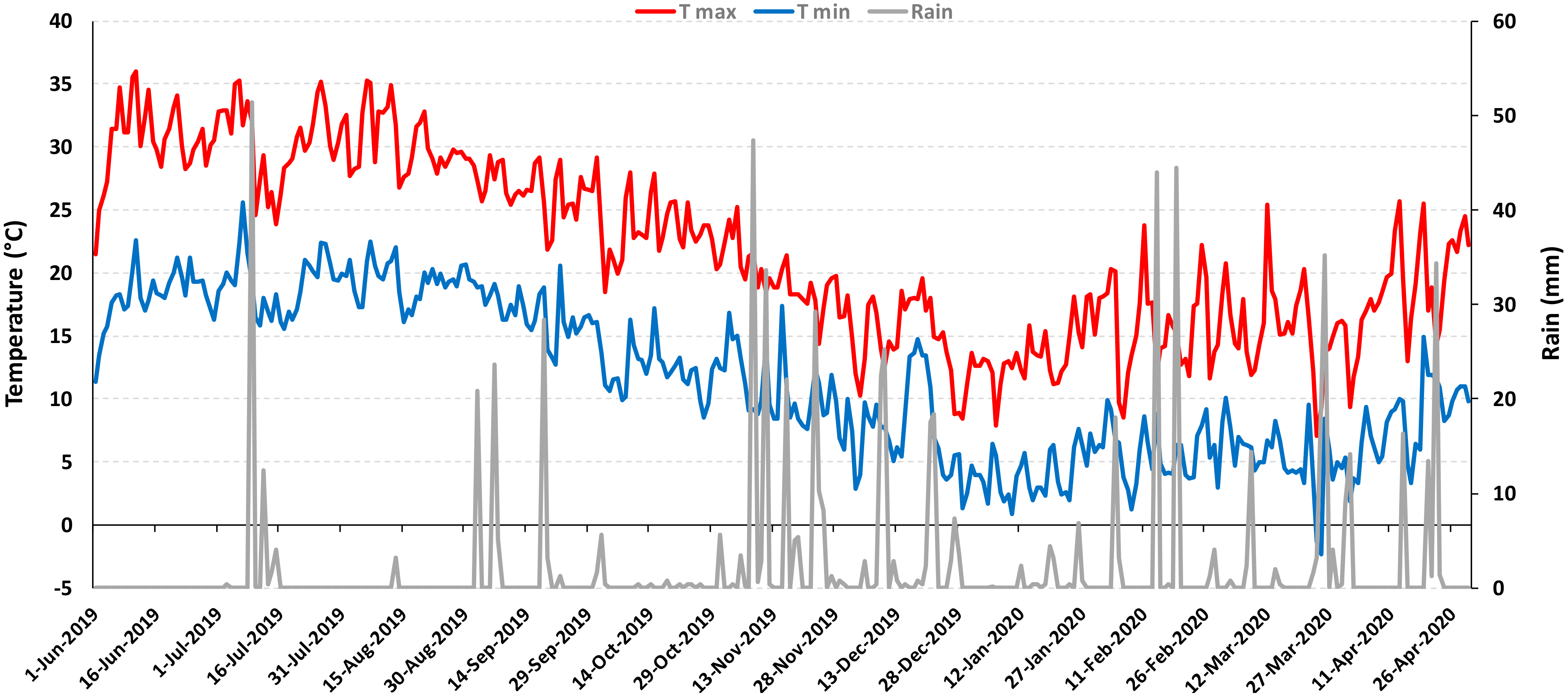1. Introduction
Maintaining the soil health in agro-ecosystems is an important principle mentioned in Regulation 2018/848 of the European Parliament and of the Council [
1] about organic farming, as well as in the “Soil Thematic Strategy”, concerning principles for protecting soil across the European Community [
2]. Another mandate assigned to sustainable agriculture is the conservation of biodiversity, which is considered an important indicator of the ability of agroecosystems to provide services to people [
3]. In this context of strategies, weeds play a pivotal role, as their correct management ensures both optimal levels of biodiversity and respect for soil functions [
4,
5,
6]. Effectively, it is well known that the environmental sustainability of organic vegetable productions is higher than in conventional systems, not only for the improvement of resource recycling and the related reduction of pollutants, but also in relation to a high level of biodiversity conservation [
7]. There is, therefore, the need to develop new approaches to weed management which simultaneously provide the elimination of competition with the crop and respect for the potential positive functions of weeds in the field [
8]. These needs are at the basis of the adoption of Integrated Weed Management techniques (IWM) defined as “
a holistic approach to weed management that integrates different methods of weed control to provide the crop with an advantage over weeds” [
9]. In this system of strategies, soil management and tillage [
10], weed management and other agronomic techniques are interconnected for the sole objective of keeping infestations at a level that guarantees optimal yields and health of agroecosystems [
11].
Globe artichoke (
Cynara cardunculus L. var.
scolymus (L.) Fiori), a species native to the Mediterranean Basin, is currently cultivated in many regions of the world although Italy represents the world leading producer. Puglia (Southern Italy) supplies about one-third of the nation’s production (about 470,000 tons) and harbors several local varieties of globe artichoke [
12,
13].
The cultivation of globe artichoke is carried out both in a perennial cycle and in an annual crop, although the second method is currently lower widespread globally. This principally due to the lack of varieties suitable for an annual cycle that would guarantee balanced yield and quality of heads [
14]. It is important to underline that the cultivation of the globe artichoke can be affected by the presence in the field of both native and non-native weed flora [
15]. The production value of globe artichoke is higher than that of other vegetables as a consequence of its well-known importance as functional food and source of pharmaceutical compounds. Traditionally, globe artichoke cultivation in the Mediterranean Basin is based on monoculture and on use of high farming inputs to improve crop yield and quality. On the other hand, it should be considered that consumers are increasing requests for food products coming from sustainable cropping systems. To this end, globe artichoke hybrids may be considered more suitable for sustainable farming since they are more vigorous and earlier and, thus, less demanding as regards input in plant protection.
The prospect of considering globe artichoke cultivation as a common annual crop could open up new scenarios for its compatibility with sustainable agriculture because some authors studied the possibility of using globe artichoke as cash and cover crop in annual rotations. In this context, several globe artichoke hybrids are currently available, which yield on the same level as plants propagated by the vegetative methods and provide high quality heads for both fresh market and processing industry [
16,
17,
18].
Apart from hybrid varieties, it should be considered that, in Puglia, some plant nurseries can offer local varieties sanitized from virus [
12]. To this end, it is important to note that despite the abundance of globe artichoke landraces in Puglia, only a small number are grown due to several factors including a poor phytosanitary status. Indeed, over time, severe production losses and reduced quality of globe artichoke have been reported due to the transmission and accumulation of viruses in vegetative-propagated plants [
12]. Therefore, the possibility to use these sanitized plants represents a great opportunity considering that consumers could prefers local varieties instead of hybrid ones. Furthermore, it should be considered that the artichoke plants, coming from a virus-sanitation protocol (which include in vitro culture), show higher vigor than vegetative-propagated plants [
19], that is a vigor similar to hybrid varieties.
To enhance globe artichoke, yield mulching of fields is recommended, although the use of biodegradable mulch films should be preferred since it represents a more environmentally friendly solution [
18]. Furthermore, living mulching can be considered another technique to be used for more sustainable cropping systems. Living mulches are cover crops grown simultaneously with and in close proximity to cash crops [
20]. Several studies reported the capacity of living mulches to improve soil health and reduce the need for intensive tillage, soil erosion, and nitrate leaching. Nevertheless, despite the potential for living mulching to enhance agroecosystem biodiversity in comparison with synthetic mulches, its diffusion is limited due to the potential competition between living mulches and cash crops [
20]. Some authors [
21] intercropped two Italian cultivars of artichokes with a living mulch mixture (
Trifolium incarnatum L.,
Vicia villosa L.,
V. faba L. var.
minor,
Coriandrum sativum L.,
Fagopyrum esculentum,
Alyssum spp.,
Pisum sativum L.,
Brassica rapa L., and
Phacelia tanacetifolia Benth) in comparison with no living mulch as a control. Results showed that living mulch did not reduce yield of either artichoke cultivars, when compared with the no living mulch ones. However, although the Puglia is one of the most important Italian regions for the cultivation of artichoke, to the best of our knowledge, there is a lack of information in literature with regard to the evaluation of mulching on this species as annual cropping.
Subterranean clover is a winter annual plant with prostrate stems. The seed germinates in late summer or early fall and plants flower in late spring. It is a self-reseeding species: after self-insemination, the peduncles of the flowers bend toward the ground, allowing the seeds ripen below the ground. Soon after the seeds are produced, the clover dies, leaving a dense, dead mulch. Due to its life cycle, it seems to be a successful living mulch in field crops such as maize. For example, its effects were found by Abdin et al. [
22] in corn, both regarding yield and weed control. The species is known for providing weed control in no-tillage systems [
23]. Furthermore, where it was combined with interrow tillage, it showed good performance [
22]. In horticultural crops, Fracchiolla et al. [
24] found report that it does not affect quality and yield of broccoli raab but it is effective in weed control.
Therefore, starting from all the above remarks, the aims of this research were: (i) to investigate the influence of mulching (both living mulches and biodegradable mulch film) on both weed infestation and globe artichoke yield in comparison with conventional tillage; and (ii) to compare its performance when used for hybrid cultivar and sanitized local variety of globe artichoke in annual cropping.
4. Discussion
The study takes into consideration the crop of globe artichoke as annual cropping in Puglia (Southern Italy). For the first time, the evaluation of both living mulch with subterranean clover and biodegradable mulch film on weed management in globe was evaluated.
The data obtained in all the surveys show a not high infestation, although rich in terms of botanical species. This evidence is likely due to the effectiveness of all treatments in controlling weeds. To give a rough indication, in neighboring areas of the field left uncultivated, between November and March the total weed cover was on average equal to 20%, while in April it was equal to about 30%. The slightly higher infestation of the month of April, is most likely due to the increase in temperatures, rainfall (
Figure 6) and daylight hours that, typically, occur in these environments. This month, therefore, coincides with that of the maximum vegetative expression of the spontaneous flora in these environments.
In terms of number of weed species detected, from November to March, the species found in the plots mulched with biodegradable film were higher in comparison with living mulch (
Table 2). These results are consistent with previous studies [
35] reporting that, in orchards, subterranean clover decreases the species richness. In April, the number of species was found quite similar among the two different soil management systems, with the beginning of the maximum weed vegetation peak.
Our experiment confirmed the ability of subterranean clover to control weed cover [
23,
24,
36,
37]. The total cover in plots with living mulch did not differ from that found in plots mulched with biodegradable film until March. This lets us assume that the clover is able to compete with weed vegetation in the same way as a physical barrier, such as that of the biodegradable film. It is also known that living mulch compete with weeds for light, soil moisture, and nitrogen (N). The competition affects the development of seedlings and reduce the vigor of adult plants [
38]. An additional effect can be due to allopathy; for example, Kahan et al. [
39] reported that legumes incorporated in the soil can reduce weed infestation in rice. Moreover, Xuan et al. [
40] found that residues of several crops, including alfalfa, can exert effective weed control. Both of these cited studies and our study, confirm that the use of living much can be an effective biological tool for weed control. In April, weed cover was higher in the plots with living mulch, particularly under the Capriccio variety. We can explain these results because the subterranean clover, after the month of November, reduced its canopy and thus its competitiveness against weeds.
The reduction of canopy with respect to November, can be due to the competition of the artichoke plants that, in recent months, became vigorous.
The reduction was even more evident in the Capriccio variety, which is more vigorous and more shading than the Brindisino variety; also, the dry weight of the above ground biomass confirms this trend. The response of
T. subterraneum to shading was expected; this species is reported as highly light-demanding [
41,
42]. Nonetheless, the clover was able to vegetate throughout the production season, albeit reducing its coverage when subjected to excessive light competition.
The observed behavior reinforces the idea that this species can be used effectively as a living mulch. In fact, it is able to favor the establishment of the crop allowing it to overcome the critical period for weed competition, reducing its biomass or disappearing completely when the crop is able to compete autonomously [
36]. Our study confirms the possibility of using this species for the living mulch also in vegetable crops as well as in orchards [
43,
44] better if they are not excessively vigorous. To this end, local varieties of globe artichoke, such as Brindisino, could be preferred, being less vigorous in comparison with hybrid cultivars and, in turn, they could be particularly advantaged by the living mulch.
Species detected in the BMs plots were those emerging from the holes in correspondence with the artichoke plants or in consequence of mechanical damages to the biodegradable film, caused by atmospheric agents or by the leaves of the underlying seedlings. Light and high temperatures play a crucial role in the degradation of biodegradable film mulch [
45,
46]. In our experiment we found that it maintained substantial integrity until the end of the production cycle, characterized by quite low temperatures; furthermore, the canopy of both varieties of globe artichoke protected the film from light radiation.
From the point of view of the structure of the infesting vegetation, a significant result is that of the similarity between the communities of species in the plots differently managed. The number of shared species indicates a substantial difference between the two communities. For example, species belonging to Asteracee family, G. disectum, and G. aparine are always present in all plots. Species belonging to Poaceae family and E. helioscopia have been found in living mulch only in the latest surveys. In any case, the difference fades in March and April.
Radicetti et al. [
47] found that, when subterranean clover was used in winter wheat, it had negative impact on growth and yield, although it reduced the density of monocotyledonous, dicotyledonous weeds by the time of crop anthesis. In our study, never conducted before for the globe artichoke, although these data must be confirmed by observations carried out over several years, the yield of plants managed with conventional tillage does not differ from those conducted with the two alternative methods studied.
When it was used as living mulch in field corn, soy beans, sweet corn, and vegetables such as summer squash, spring cabbage, snap beans, and tomatoes, it provided excellent weed control and no competition with crop yield [
23]. Furthermore, Enache et al. [
36] report good results in weed control and crop yield in field corn. Moreover, weed suppression with
T. subterraneum was reported equal to 71%, with respect to the control, in sugar beet and the use of living mulch reduced herbicide input up to 65% [
48].
Fracchiolla et al. [
24] showed the positive effects of living mulch and organic fertilization in the production of broccoli raab, both for weed control and for crop yield and quality.
Hollander et al. [
37] reported that subterranean clover, used in leek, caused reductions in individual plant weight, because plants were completely entangled within the clover canopy.
The different results are most likely due to the different eco-physiological traits of the different crops and, above all, the length of their critical period of weed competition [
49,
50].
We highlight the possibility of introducing conservation agriculture practices in the management of the globe artichoke, acquiring the advantages of this system. This is likely due to the plant being able to develop high canopy after a short time. Sustainable agriculture is based on best management practices; among these, the promotion of minimal soil disturbance, in order to reduce the consumption of fossil fuels, avoids soil erosion, and maintains soil physical and biological health [
51,
52,
53].
Some authors reported that in temperate areas, only a few fast-establishing annual legumes suitable as living mulches are available. Therefore,
T. subterraneum is confirmed, even in our study, an important species for these purposes [
54].
In agreement, our results show that the use of mulching instead of conventional tillage allows to obtain a sustainable weed management in globe artichoke also in terms of respect for the potential positive functions of weeds in the field [
8] when they do not compete with the crop, that is another way to safeguard the biodiversity.
With the aim to better discuss the several aspects regarding the use of subterranean clover as living mulch for weed management in globe artichoke cropping it is interesting to evaluate each statement of the SWOT analysis (
Table 8).
Regarding the strengths, it is important to first specify that the subterranean clover did not affect the yield of globe artichoke for both genotypes in comparison with biodegradable mulch film and conventional tillage. At the same time, this species showed a good ability to control weed cover especially under Brindisino genotype highlighting its particularly suitability for local varieties of globe artichoke instead of hybrid cultivars. This is because subterranean clover is a high light-demand species and local varieties caused less shading being less vigorous than hybrid cultivars. Therefore, the use of this species for the weed management in globe artichoke crop may be particularly interesting in Puglia where predominate the cultivation of local varieties [
13,
55]. Regarding the economic aspects, it is important to highlight that the cost of using subterranean clover as living mulch can be three-fold lower in comparison with biodegradable films (about 300 EUR ha
−1 for subterranean clover vs. about 1000 EUR ha
−1 for biodegradable films). Another strength of the subterranean clover regards the possibility of increasing the soil nitrogen content through nitrogen fixing, being a leguminous species. Furthermore, it should be considered the self-reseeding capacity which would allow to take advantage the living mulch for a next intercropping without the need to carry out a new sowing of the subterranean clover. In this context, it is appropriate to spread the sowing cost of the subterranean clover for at least two years. Anyway, the use of subterranean clover as living mulch might not allow a uniform cover due to the variable germinability of the seed in open field.
All the strengths can be translated in some opportunities regarding the use of subterranean clover as living mulch for weed management in globe artichoke cropping. First of all, the possibility of integrating this intercropping into an organic artichoke cultivation system for weed management, but also for the purpose of biodiversity conservation. Furthermore, there would be the possibility to valorize other local varieties of Puglia artichoke if we consider the possibility of using this species as cash and cover crop in annual rotations. This represents a great opportunity considering that consumers could prefer local varieties instead of hybrid cultivar. To this end, it is important to highlight that, apart from Brindisino, other local varieties are also available sanitized plants [
12] to be used for the globe artichoke production as annual cropping. Furthermore, it should be considered that the use of living mulch instead of conventional tillage can reduce the soil disturbance also promoting virtuous rhizosphere interactions [
21]. On the other hand, some threats may arise due to the potential resistance of farmers regarding the intercropping with the subterranean clover instead of other soil management techniques traditionally used in Puglia. Moreover, the seed supply of subterranean clover may not be enough to satisfy a potential rising demand by farmers in the absence of an increase in seed production of this leguminous species.
